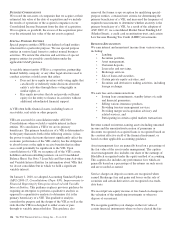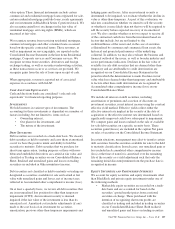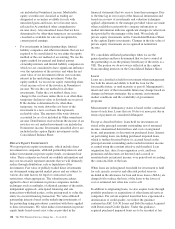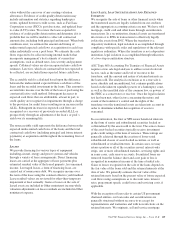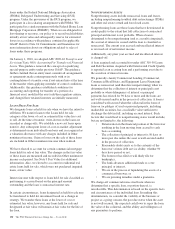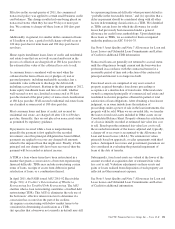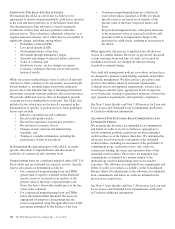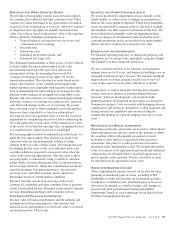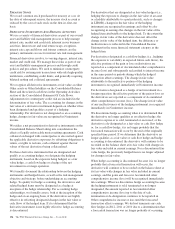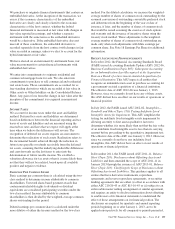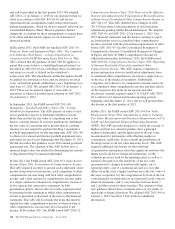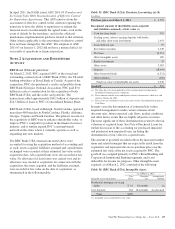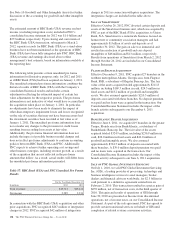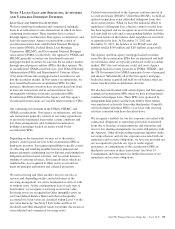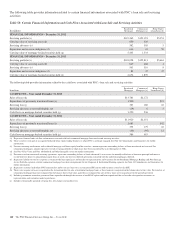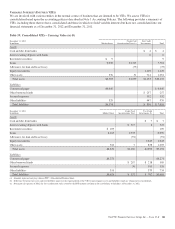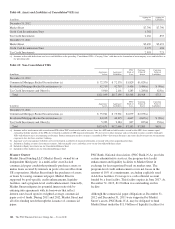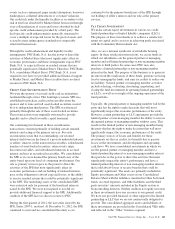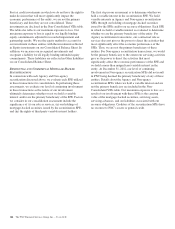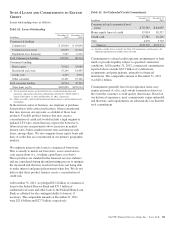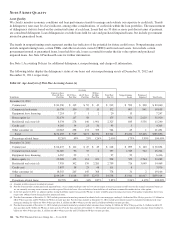PNC Bank 2012 Annual Report Download - page 155
Download and view the complete annual report
Please find page 155 of the 2012 PNC Bank annual report below. You can navigate through the pages in the report by either clicking on the pages listed below, or by using the keyword search tool below to find specific information within the annual report.and will be provided in the first quarter 2013. We adopted
ASU 2011-11 on January 1, 2013 for our derivatives that we
offset in accordance with ASC 815-10-45 and for our
repurchase/resale arrangements under enforceable master
netting arrangements, which we do not currently offset on our
Consolidated Balance Sheet. The new guidance did not
change the accounting for these arrangements or require them
to be offset and thus had no impact on our statement of
financial position.
In December 2011, the FASB also finalized ASU 2011-10,
Property, Plant, and Equipment (Topic 360) – Derecognition
of in Substance Real Estate – a Scope Clarification (a
consensus of the FASB Emerging Issues Task Force). This
ASU clarified that the guidance in ASC 360-20 applies to a
parent that ceases to have a controlling financial interest (as
described in ASC 810-10) in a subsidiary that is in substance
real estate as a result of default on the subsidiary’s
nonrecourse debt. The amendments within this update should
be applied on a prospective basis and are effective for fiscal
years, and interim periods within those years, beginning on or
after June 15, 2012. We adopted ASU 2011-10 on January 1,
2013. There was no material impact to our results of
operations or financial position upon adoption of ASU 2011-
10 on January 1, 2013.
In September 2011, the FASB issued ASU 2011-08,
Intangibles – Goodwill and Other (Topic 350) : Testing
Goodwill for Impairment. The ASU permits an entity to first
assess qualitative factors to determine whether it is more
likely than not that the fair value of a reporting unit is less
than its carrying amount. If an entity qualitatively determines
the fair value of a reporting unit is greater than its carrying
amount, it is not required to perform the Step 1 quantitative
goodwill impairment test for the reporting unit. ASU 2011-08
is effective for annual and interim goodwill impairment tests
performed for fiscal years beginning after December 15, 2011.
We did not utilize this guidance in our 2012 annual goodwill
impairment test. The adoption of this ASU did not have a
financial impact since the method for determining the amount
of impairment (Step 2) remained unchanged.
In June 2011, the FASB issued ASU 2011-05 Comprehensive
Income (Topic 220): Presentation of Comprehensive Income.
This ASU required an entity to present each component of net
income along with total net income, each component of other
comprehensive income along with total other comprehensive
income, and a total amount for comprehensive income either
in a single continuous statement of comprehensive income or
in two separate but consecutive statements. In both
presentation options, the tax effect for each component must
be presented in the statement in which other comprehensive
income is presented or disclosed in the notes to the financial
statements. This ASU did not change the items that must be
reported in other comprehensive income or when an item of
other comprehensive income must be reclassified to net
income. In December 2011, the FASB issued ASU 2011-12,
Comprehensive Income (Topic 220): Deferral of the Effective
Date for Amendments to the Presentation of Reclassifications
of Items Out of Accumulated Other Comprehensive Income in
ASU 2011-05. This ASU deferred those changes in ASU
2011-05 that relate to the presentation of reclassification
adjustments pending further Board deliberation. We adopted
ASU 2011-05 and ASU 2011-12 on January 1, 2012. Our
2012 financial statements and disclosures continue to report
reclassifications out of accumulated other comprehensive
income consistent with the presentation requirements in effect
before ASU 2011-05. See the Consolidated Statement of
Comprehensive Income, Consolidated Statement of Changes
in Equity and Note 20 Other Comprehensive Income for
additional information. In February 2013, the FASB issued
ASU 2013-02, Comprehensive Income (Topic 220): Reporting
of Amounts Reclassified Out of Accumulated Other
Comprehensive Income. This ASU requires companies to
present information about reclassification adjustments from
accumulated other comprehensive income in a single note or
on the face of the financial statements. Additionally,
companies are to disclose by component reclassifications out
of accumulated other comprehensive income and their effects
on the respective line items on net income and other
disclosures currently required under U.S. GAAP. ASU 2013-
02 is effective for annual and interim reporting periods
beginning after December 15, 2012 and we will present these
disclosures in the first quarter of 2013.
In May 2011, the FASB issued ASU 2011-04 Fair Value
Measurement (Topic 820), Amendments to Achieve Common
Fair Value Measurement and Disclosure Requirements in U.S.
GAAP and International Financial Reporting Standards
(IFRS). This ASU provides guidance to clarify the concept of
highest and best use valuation premise, how a principal
market is determined, and the application of the fair value
measurement for instruments with offsetting market or
counterparty credit risks. It also extends the prohibition on
blockage factors to all fair value hierarchy levels. This ASU
required additional disclosures for the following:
(i) quantitative information about the significant unobservable
inputs used in all Level 3 financial instruments, (ii) the
valuation processes used by the reporting entity as well as a
narrative description of the sensitivity of the fair value
measurement to changes in unobservable inputs, (iii) a
reporting entity’s use of a nonfinancial asset in a way that
differs from the asset’s highest and best use if the fair value of
the asset is reported, (iv) the categorization by level of the fair
value hierarchy for items that are not measured at fair value in
financial statements, and (v) any transfers between Level 1
and 2 and the reason for those transfers. The adoption of this
new guidance did not have a material effect on our results of
operations or financial position. We adopted ASU 2011-04 on
January 1, 2012. See Note 9 Fair Value for additional
information.
136 The PNC Financial Services Group, Inc. – Form 10-K


